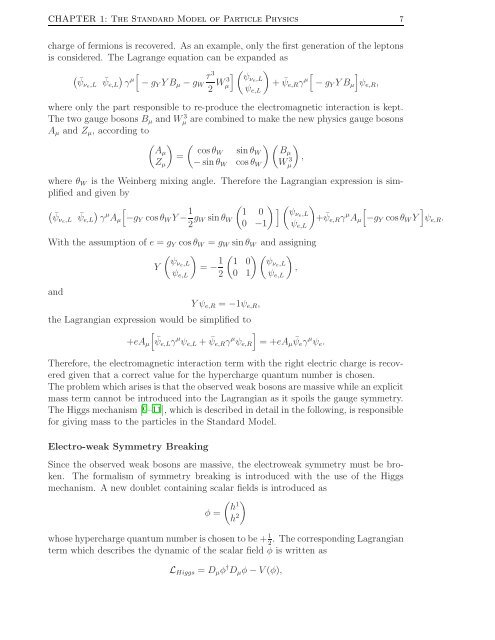6 CHAPTER 1: The Standard Model <strong>of</strong> Particle Physicswas proposed, as <strong>the</strong> operator (1 − γ 5 ) is <strong>the</strong> chirality projector that only keeps <strong>the</strong>left-handed part <strong>of</strong> <strong>the</strong> Dirac sp<strong>in</strong>or, for example one can haveP L ψ e ≡ (1 − γ5 )ψ e = ψ e,L .2In order to keep <strong>the</strong> Lagrangian <strong>in</strong>variant under <strong>the</strong> gauge transformation, <strong>the</strong> SU(2) Lsymmetry group is proposed for which <strong>the</strong> new doublets Ψ, constructed from <strong>the</strong> lefthandedDirac sp<strong>in</strong>ors, are <strong>the</strong> representations <strong>of</strong> <strong>the</strong> gauge group which are expressedexplicitly for <strong>the</strong> first generation <strong>of</strong> <strong>the</strong> fermions asΨ Lepton =( )ψνe,Lψ e,Land Ψ Quark =( )ψu,L,ψ d,Land <strong>the</strong> Pauli matrices τ i , are <strong>the</strong> generators <strong>of</strong> <strong>the</strong> group. The three massless gaugebosons which are <strong>in</strong>troduced <strong>in</strong> this group are not able to expla<strong>in</strong> <strong>the</strong> <strong>experiment</strong>aldata, be<strong>in</strong>g <strong>the</strong> three massive particles W ± and Z. Hence <strong>the</strong> idea <strong>of</strong> unification<strong>of</strong> <strong>the</strong> electromagnetism and weak <strong>in</strong>teration was made to comb<strong>in</strong>e <strong>the</strong> two type <strong>of</strong>physics <strong>in</strong>teractions <strong>in</strong>to one unified <strong>the</strong>ory called electroweak which is expla<strong>in</strong>ed <strong>in</strong><strong>the</strong> follow<strong>in</strong>g.In order to comb<strong>in</strong>e <strong>the</strong> electromagnetic and weak <strong>in</strong>teractions <strong>in</strong>to a s<strong>in</strong>gle formalism,a new symmetry group U(1) Y , called hypercharge, is <strong>in</strong>troduced and <strong>the</strong> Lagrangianis modified and expressed asL electroweak = ∑ [¯Ψf iγ µ D µ Ψ f + ¯ψ]f,R iγ µ D µ ψ f,R + K<strong>in</strong>etic terms.,fwhere <strong>the</strong> sum is over all fermions and R refers to <strong>the</strong> right-handed Dirac sp<strong>in</strong>orswhich are obta<strong>in</strong>ed by apply<strong>in</strong>g <strong>the</strong> right-handed chirality operator (1+γ5 ), on <strong>the</strong> Dirac2sp<strong>in</strong>ors. The def<strong>in</strong>ition <strong>of</strong> <strong>the</strong> covariant derivative D µ , is different depend<strong>in</strong>g on whichoperand it is act<strong>in</strong>g. The covariant derivatives <strong>of</strong> doublets and s<strong>in</strong>glets are respectivelyexpressed asτ iD µ = ∂ µ + ig Y Y B µ + ig W2 W µ i ,andD µ = ∂ µ + ig Y Y B µ ,where Y is <strong>the</strong> hypercharge operator. The constants g Y and g W represent respectively<strong>the</strong> coupl<strong>in</strong>g strengths <strong>of</strong> <strong>the</strong> hypercharge and weak <strong>in</strong>tractions. The three W i and oneB gauge bosons are comb<strong>in</strong>ed to express <strong>the</strong> observed physical <strong>in</strong>termediate bosons γ,W ± and Z, as expla<strong>in</strong>ed below.As a consequence <strong>of</strong> <strong>in</strong>troduc<strong>in</strong>g <strong>the</strong> new hypercharge symmetry group, <strong>the</strong> electroweakpart <strong>of</strong> <strong>the</strong> Standard Model can be described on <strong>the</strong> basis <strong>of</strong> <strong>the</strong> SU(2) L ⊗U(1) Y gaugegroup. Therefore, <strong>the</strong> left-handed fermions <strong>in</strong> doublets and right-handed fermions <strong>in</strong>s<strong>in</strong>glets are representations <strong>of</strong> this new symmetry group. The quantum numbers whichare assigned to <strong>the</strong> hypercharge operator Y , as well as <strong>the</strong> weak isosp<strong>in</strong> operators,be<strong>in</strong>g <strong>the</strong> Pauli matrices, are determ<strong>in</strong>ed <strong>in</strong> such a way that <strong>the</strong> appropriate electric
CHAPTER 1: The Standard Model <strong>of</strong> Particle Physics 7charge <strong>of</strong> fermions is recovered. As an example, only <strong>the</strong> first generation <strong>of</strong> <strong>the</strong> leptonsis considered. The Lagrange equation can be expanded as(¯ψνe,L ¯ψ)e,L γµ[τ 3 ] ( )− g Y Y B µ − g W2 W µ3 ψ νe,L+ψ ¯ψ[e,R γ µ − g Y Y B µ]ψ e,R ,e,Lwhere only <strong>the</strong> part responsible to re-produce <strong>the</strong> electromagnetic <strong>in</strong>teraction is kept.The two gauge bosons B µ and Wµ 3 are comb<strong>in</strong>ed to make <strong>the</strong> new physics gauge bosonsA µ and Z µ , accord<strong>in</strong>g to( ) ( ) ( )Aµ cosθW s<strong>in</strong> θ=W BµZ µ − s<strong>in</strong> θ W cos θ W Wµ3 ,where θ W is <strong>the</strong> We<strong>in</strong>berg mix<strong>in</strong>g angle. Therefore <strong>the</strong> Lagrangian expression is simplifiedand given by(¯ψνe,L ¯ψ)e,L γ µ A µ[−g Y cosθ W Y − 1 ( ) 1 0 ] (2 g ψνe,LW s<strong>in</strong> θ W0 −1With <strong>the</strong> assumption <strong>of</strong> e = g Y cosθ W = g W s<strong>in</strong> θ W and assign<strong>in</strong>g( )ψνe,LY = − 1 ( ) ( ) 1 0 ψνe,L,ψ e,L 2 0 1 ψ e,LandY ψ e,R = −1ψ e,R ,<strong>the</strong> Lagrangian expression would be simplified to+eA µ[¯ψe,L γ µ ψ e,L + ¯ψ e,R γ µ ψ e,R]= +eA µ ¯ψe γ µ ψ e .ψ e,L)+ ¯ψ e,R γ µ A µ[−g Y cosθ W YTherefore, <strong>the</strong> electromagnetic <strong>in</strong>teraction term with <strong>the</strong> right electric charge is recoveredgiven that a correct value for <strong>the</strong> hypercharge quantum number is chosen.The problem which arises is that <strong>the</strong> observed weak bosons are massive while an explicitmass term cannot be <strong>in</strong>troduced <strong>in</strong>to <strong>the</strong> Lagrangian as it spoils <strong>the</strong> gauge symmetry.The Higgs mechanism [9–11], which is described <strong>in</strong> detail <strong>in</strong> <strong>the</strong> follow<strong>in</strong>g, is responsiblefor giv<strong>in</strong>g mass to <strong>the</strong> particles <strong>in</strong> <strong>the</strong> Standard Model.Electro-weak Symmetry Break<strong>in</strong>gS<strong>in</strong>ce <strong>the</strong> observed weak bosons are massive, <strong>the</strong> electroweak symmetry must be broken.The formalism <strong>of</strong> symmetry break<strong>in</strong>g is <strong>in</strong>troduced with <strong>the</strong> use <strong>of</strong> <strong>the</strong> Higgsmechanism. A new doublet conta<strong>in</strong><strong>in</strong>g scalar fields is <strong>in</strong>troduced as( ) h1φ =h 2whose hypercharge quantum number is chosen to be + 1 . The correspond<strong>in</strong>g Lagrangian2term which describes <strong>the</strong> dynamic <strong>of</strong> <strong>the</strong> scalar field φ is written asL Higgs = D µ φ † D µ φ − V (φ),]ψ e,R .
















